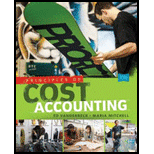
Concept explainers
Analysis of materials and labor variances
High-End Products Inc. uses a
Direct materials: 10 feet of Class at $.75 per foot and 3 feet of Chic at $1.00 per foot.
Direct labor: 4 hours at $12.00 per hour.
Factory
There was no beginning inventory on hand at July 1. Following is a summary of costs and related data for the production of Swank during the following year ended June 30:
100,000 feet of Class were purchased at $.72 per foot.
30,000 feet of Chic were purchased at $1.05 per foot.
8,000 units of Swank were produced that required 78,000 feet of Class, 26,000 feet of Chic, and 31,000 hours of direct labor at $11.80 per hour.
6,000 units of product Swank were sold.
On June 30, there are 22,000 feet of Class, 4,000 feet of Chic, and 2,000 completed units of Swank on hand. All purchases and transfers are “charged in” at standard.
Required:
Calculate the following, using the formulas on pages 421–422 and 424 and compute the materials variances for both Class and Chic:
- 1. Materials quantity variance.
- 2. Materials purchase price variance.
- 3. Labor efficiency variance.
- 4. Labor rate variance.
Want to see the full answer?
Check out a sample textbook solution
Chapter 8 Solutions
Principles of Cost Accounting
Additional Business Textbook Solutions
Essentials of MIS (13th Edition)
Microeconomics
Gitman: Principl Manageri Finance_15 (15th Edition) (What's New in Finance)
Principles of Microeconomics (MindTap Course List)
Principles of Operations Management: Sustainability and Supply Chain Management (10th Edition)
Marketing: An Introduction (13th Edition)
- Using the Sales Total vs Sales Order Counts by Channel in 2022 visualization, what trends are shown for the B2B sales channel? What recommendations do you have for management for the B2B strategy? What are some considerations when pursuing a B2B strategy?arrow_forwardCan you provide a detailed solution to this financial accounting problem using proper principles?arrow_forwardUsing the results of the Top 5 Customers by Accounts Receivable Amount Due and the Top 5 Customers by Outstanding Sales Order Amount visualization, what conclusion can be made regarding the outstanding sales orders? a. The high value of outstanding accounts receivable for Sanders Corp may be directly related to their high value of outstanding sales orders. b. The high value of outstanding accounts receivable for Williams Corp may be directly related to their high value of outstanding sales orders. c. The high value of outstanding sales orders for Roberts Corp has caused them not to pay a large value of invoices. d. Evans Corp has a high value of outstanding accounts receivable and outstanding sales orders.arrow_forward
- Based on the dashboard, what recommendations would you give to improve the overall sales and revenue of Borders USA? Is there any additional information would you like to have to provide useful recommendations? What are your interpretations of AR Aging and Sales Order Aging dashboards?arrow_forward1. Using the Sales vs Revenue by Quarter in 2022 visualization, what trends are being shown between sales and revenue? a. Sales was variable for each quarter, but revenue decreased every quarter. b. Sales decreased every quarter, but revenue was variable for each quarter. c. Revenue was higher than sales for each quarter. d. Revenue was lower than sales for only the first two quarters.arrow_forwardI need help with this financial accounting problem using accurate calculation methods.arrow_forward
- Please provide the accurate answer to this general accounting problem using valid techniques.arrow_forwardCan you help me solve this general accounting problem using the correct accounting process?arrow_forwardI need help solving this general accounting question with the proper methodology.arrow_forward
 Managerial Accounting: The Cornerstone of Busines...AccountingISBN:9781337115773Author:Maryanne M. Mowen, Don R. Hansen, Dan L. HeitgerPublisher:Cengage Learning
Managerial Accounting: The Cornerstone of Busines...AccountingISBN:9781337115773Author:Maryanne M. Mowen, Don R. Hansen, Dan L. HeitgerPublisher:Cengage Learning Managerial AccountingAccountingISBN:9781337912020Author:Carl Warren, Ph.d. Cma William B. TaylerPublisher:South-Western College Pub
Managerial AccountingAccountingISBN:9781337912020Author:Carl Warren, Ph.d. Cma William B. TaylerPublisher:South-Western College Pub Cornerstones of Cost Management (Cornerstones Ser...AccountingISBN:9781305970663Author:Don R. Hansen, Maryanne M. MowenPublisher:Cengage Learning
Cornerstones of Cost Management (Cornerstones Ser...AccountingISBN:9781305970663Author:Don R. Hansen, Maryanne M. MowenPublisher:Cengage Learning Financial And Managerial AccountingAccountingISBN:9781337902663Author:WARREN, Carl S.Publisher:Cengage Learning,Principles of Accounting Volume 2AccountingISBN:9781947172609Author:OpenStaxPublisher:OpenStax College
Financial And Managerial AccountingAccountingISBN:9781337902663Author:WARREN, Carl S.Publisher:Cengage Learning,Principles of Accounting Volume 2AccountingISBN:9781947172609Author:OpenStaxPublisher:OpenStax College Principles of Cost AccountingAccountingISBN:9781305087408Author:Edward J. Vanderbeck, Maria R. MitchellPublisher:Cengage Learning
Principles of Cost AccountingAccountingISBN:9781305087408Author:Edward J. Vanderbeck, Maria R. MitchellPublisher:Cengage Learning





